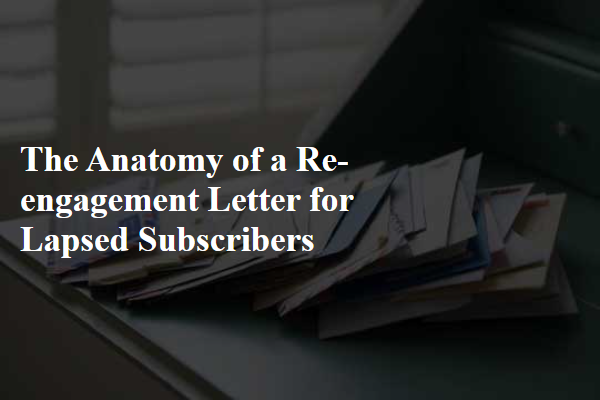
A re-engagement letter for lapsed subscribers effectively rekindles interest by addressing the subscriber by name, acknowledging their lapse, and offering value-driven incentives such as exclusive discounts or personalized content. Clear, concise language paired with a strong call-to-action encourages subscribers to renew seamlessly. Including social proof and easy opt-out options builds trust and enhances the likelihood of reactivation.
Understanding Lapsed Subscriber Behavior
A re-engagement letter targets lapsed subscribers to renew their interest and regain their active status. It outlines personalized offers and highlights the benefits of resubscribing to foster renewed engagement.
The structure includes a compelling subject line, a clear call-to-action, and value-driven content tailored to the subscriber's previous interactions. Including incentives such as discounts or exclusive access increases the likelihood of subscriber reactivation.
Importance of Re-engagement Letters
A re-engagement letter targets lapsed subscribers to renew interest and reduce churn. It serves as a crucial tool to reconnect with an audience that has become inactive over time.
The anatomy of an effective re-engagement letter includes a personalized greeting to capture attention immediately. Clear messaging highlights the benefits of resubscribing while addressing potential reasons for inactivity. A compelling call-to-action encourages recipients to take prompt steps toward reactivating their subscription.
Key Elements of an Effective Re-engagement Letter
| Section | Description | Key Elements |
|---|---|---|
| Header | The opening part of the re-engagement letter that grabs attention and identifies the sender | Company logo, sender's name, contact details |
| Personalized Greeting | Addressing the subscriber by name to create a personal connection | Subscriber's first name, friendly tone |
| Introduction | Brief message acknowledging the subscriber's absence or inactivity | Reference to subscription status, date of last engagement |
| Value Proposition | Highlighting benefits of re-subscribing or renewing engagement | Exclusive offers, new content, updates, discounts |
| Call to Action (CTA) | Encouraging the subscriber to take specific action such as clicking a link or renewing subscription | Clear and direct language, clickable button or link, urgency indicators |
| Social Proof | Including testimonials, reviews, or numbers to build trust and credibility | User reviews, subscriber counts, endorsements |
| Contact Information | Ways for the subscriber to reach out for help or more information | Customer service email, phone number, live chat links |
| Unsubscribe Option | Respectful way to allow the subscriber to opt out | Unsubscribe link, clear instructions |
| Footer | Legal disclaimers and company details at the bottom of the letter | Company address, privacy policy link, copyright notice |
Personalization Strategies for Higher Response Rates
A re-engagement letter targets lapsed subscribers to renew their interest and prompt action. It combines personalized content with clear calls to action to recapture attention effectively.
Key components include a compelling subject line, a reminder of previous value, and an exclusive offer or incentive. Timing and relevance are crucial to maximize reopening engagement and reduce unsubscribe rates.
Compelling Subject Lines That Win Back Attention
A re-engagement letter targets lapsed subscribers to renew their interest and subscription. The letter's structure is crucial for maximizing response rates and rebuilding customer relationships.
- Personalized Greeting - Addresses the subscriber by name to create a sense of individual attention and relevance.
- Clear Purpose - States the reason for the letter upfront, reminding the subscriber of the value they once received.
- Compelling Call-to-Action - Includes an enticing offer or incentive that encourages immediate re-subscription.
Crafting a Persuasive Call to Action
A re-engagement letter for lapsed subscribers aims to revive interest by acknowledging the subscriber's absence and offering value-driven incentives. Effective letters personalize the message using subscriber data and highlight benefits tailored to the recipient's preferences. Clear calls to action and concise content enhance the likelihood of reactivation and renewal of subscription commitment.
Timing Your Re-engagement Efforts
A re-engagement letter targets lapsed subscribers to renew their interest and loyalty. Crafting an effective letter involves strategic content, personalization, and clear calls to action.
- Personalized Greeting - Using the subscriber's name increases engagement and creates a direct connection.
- Clear Value Proposition - Highlighting benefits reminds subscribers why they joined and what they gain.
- Compelling Call to Action - Encouraging immediate response improves the chances of reactivation.
Including a sense of urgency or exclusive offers can further motivate lapsed subscribers to reconnect with the brand.
Using Incentives to Encourage Renewal
Re-engagement letters are essential tools for regaining interest from lapsed subscribers. These letters strategically combine clear messaging and personalized content to rekindle customer engagement.
- Compelling Subject Line - Grabs the subscriber's attention immediately to increase open rates.
- Personalized Greeting - Addresses the subscriber by name to create a direct and personal connection.
- Clear Call-to-Action - Encourages the subscriber to take a specific step, such as updating preferences or making a purchase.
Measuring the Success of Your Re-engagement Campaign
What is the anatomy of a re-engagement letter for lapsed subscribers? A re-engagement letter aims to reconnect with inactive subscribers by addressing their needs and renewing their interest. It typically includes personalized content, a clear call-to-action, and incentives to encourage reactivation.
Best Practices for Retaining Re-engaged Subscribers
A re-engagement letter for lapsed subscribers aims to rekindle interest and restore active participation. It typically includes a personalized greeting, a reminder of the subscriber's previous engagement, and a compelling call-to-action offering value or incentives. Effective letters use clear subject lines, concise language, and emotional appeal to increase response rates and subscriber retention.



Comments